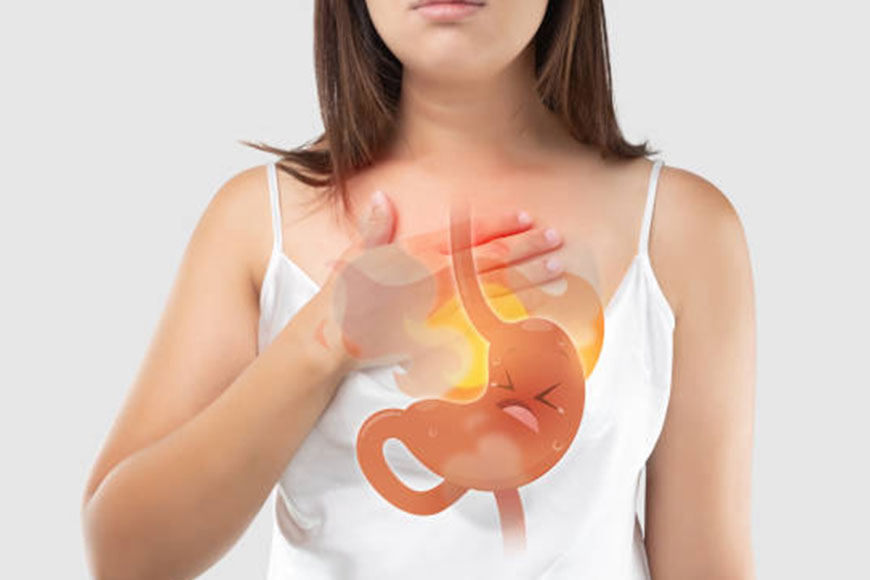Diagnose
Your doctor may be able to diagnose GERD based on a physical exam and a history of your signs and symptoms.

To confirm a diagnosis of the GERD, or to check for complications, your doctor may recommend:
1. Upper endoscopy
Your doctor inserts a thin, flexible tube with a light and camera (endoscope) down your throat to examine the inside of your esophagus and stomach. Test results are often normal when reflux is present, but the endoscopy may reveal inflammation of the esophagus (esophagitis) or other complications. An endoscopy may also be used to collect a sample of tissue (biopsy) to be examined for complications such as Barrett’s esophagus.
2. Mobile acid (pH) probe test
A device is placed in the esophagus to determine when and for how long stomach acid will reflux there. The monitor connects to a small computer that you wear around your waist or a strap on your shoulder. The monitor may be a thin, flexible tube (catheter) passed through your nose into the esophagus, or a clip that is placed into the esophagus during endoscopy and passed in the stool about two days later.
3. Esophageal manometry
This test measures regular muscle contractions in the esophagus when swallowing. Esophageal manometry also measures the coordination and force exerted by the esophageal muscles.
4. X-ray of the upper gastrointestinal tract
An X-ray is taken after you drink a chalky liquid that coats and fills the inner lining of your digestive system. The wrap allows your doctor to see the silhouette of your esophagus, stomach, and upper intestine. You may also be asked to swallow a barium pill, which can help diagnose esophageal strictures that may interfere with swallowing.
Treatment
Your doctor will likely recommend that you try lifestyle modifications and take over-the-counter medications first. If you do not feel relief within a few weeks, your doctor may recommend a prescription or surgery.
Over-the-counter drugs
Options include:
1. Antacids that neutralize stomach acid
Antacids, such as Mylanta, Rolide, and Toms, may provide quick relief. But the antacids alone won’t heal an inflamed esophagus damaged by stomach acid. Overusing some antacids can sometimes cause side effects, such as diarrhea or kidney problems.
2. Medicines to reduce acid production
These drugs – known as H-2 receptor blockers – include cimetidine (Tagamet HB), famotidine (Pepcid AC) and nizatidine (Axide AR). H-2 receptor blockers do not work as quickly as antacids, but they provide longer relief and may reduce acid production from the stomach for up to 12 hours. Stronger versions are available by prescription.
3. Medicines that block acid production and treat the esophagus
These medications known as the proton pump inhibitors are stronger acid blockers than H-2 receptor blockers and allow time for damaged esophageal tissue to heal. Over-the-counter proton pump inhibitors include lansoprazole (Prevacid 24hr) and omeprazole (Prilosec OTC, Zegerid OTC).
Medicines
Strong prescription treatments for GERD include:
1. Strong prescription H-2 receptor blockers
These medications include famotidine (Pepcid) and nizatidine. These medications are generally well tolerated but their long-term use may be associated with a slightly increased risk of vitamin B12 deficiency and bone fractures.
2. Strong prescription proton pump inhibitors
These medications include esomeprazole (Nexium), lansoprazole (Prevacid), omeprazole (Prilosec, Zegerid), pantoprazole (Protonix), rabeprazole (Aciphex) and dexlansoprazole (Dexilant). Although these medications are generally well tolerated, they may cause diarrhea, headache, nausea, and vitamin B12 deficiency. Chronic use may increase the risk of developing a hip fracture.
3. Medication to strengthen the lower esophageal sphincter
Baclofen may relieve GERD by decreasing the frequency of relaxation of the lower esophageal sphincter. Side effects may include the fatigue or nausea.
Surgery and other procedures
Gastroesophageal reflux disease can be controlled with medication. But if medications don’t help or you want to avoid long-term use of medications, your doctor may recommend:
1. Fundoplication
The surgeon wraps the upper part of your stomach around the lower esophageal sphincter to tighten the muscles and prevent GERD. Fundoplication is usually done through a minimally invasive (laparoscopic) procedure. The bypass of the upper part of the stomach can be partial or complete.
2. LINX device
A ring of the tiny magnetic beads is wrapped around the junction of the stomach and esophagus. The magnetic attraction between the grains is strong enough to keep the junction closed to reflux acid, but weak enough to allow food to pass through. The LINX can be implanted using minimally invasive surgery.
3. Transoral fundoplication (TIF)
This new procedure involves tightening the lower esophageal sphincter by making a partial wrap around the lower esophagus using polypropylene stabilizers. TIF is performed through the mouth with a device called an endoscope and does not require a surgical incision. Its advantages include the fast recovery time and high tolerance.
If you have a large hiatal hernia, the TIF alone is not an option. However, it may be the possible if TIF is combined with laparoscopic hiatal hernia repair.

